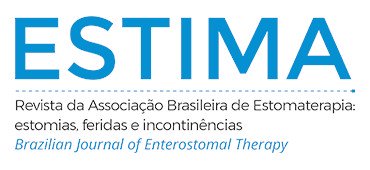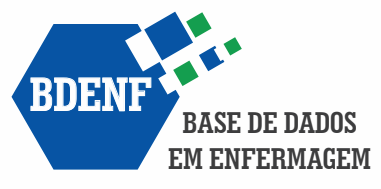Development of educational material for the prevention and treatment of friction injuries
Abstract
Objective: to develop and validate an educational booklet to help health professionals to prevent and treat friction injuries. Method: methodological study. An integrative review of the literature of journals published between 2009 and 2019 was carried out in the main databases of Health Sciences. The evaluation of the educational booklet was conducted with 32 nurses, using the Delphi technique. The statistical analysis used was the Content Validity Index. Results: the judges considered the content of the educational booklet between the concepts “inadequate” and “adequate”, in the first assessment; after the corrections requested by the judges, the booklet was forwarded to the evaluators and the content of the educational booklet was rated between “adequate” and “totally adequate”. The overall Content Validity Index was 0.8118 in the first assessment and 1.0 in the second assessment. Conclusion: after the integrative literature review, the material was constructed and validated by professionals with experience in evaluating and treating individuals with wounds, obtaining consensus among the evaluators in the second evaluation.
Downloads
Metrics
References
Lichterfeld-Kottner A, El Genedy M, Lahmann N, Blume- Peytavi U, Büscher A, Kottner J. Maintaining skin integrity in the aged: a systematic review. Int J Nurs Stud 2020;103:103509. https://doi.org/10.1016/j.ijnurstu.2019.103509
Rayner R, Carville K, Leslie G, Dhaliwal SS. Models for predicting skin tears: A comparison. Int Wound J. 2020 Jun;17(3):823-830. https://doi.org/10.1111/iwj.13340
Silva CVB, Camanili TCGF, Freitas NO, LeBlanc K, Baranoski S, Santos VLCG. ISTAP classification for skin tears: validation for brazilian portuguese. Int Wound J 2020;17(2):310-6. https://doi.org/10.1111/iwj.13271
Scheele CM, Göhner W, Schumann H. Cross-sectional study on skin tears in fragile, aging skin: nursing deficits in a common problem in Germany. Pflege 2020;33(3):123-32. https://doi.org/10.1024/1012-5302/a000742
Langemo DK, Williams A, Edwards K. Skin tears: prevention and management. Nursing 2019;49(4):66-9. https://doi.org/10.1097/01.NURSE.0000554309.45660.ca
Rayner R, Carville K, Leslie G, Dhaliwal SS. A risk model for prediction of skin tears in aged care residents: a prospective cohort study. Int Wound J 2019;16(1):52-63. https://doi.org/10.1111/iwj.12985
Brown A. Skin tears: Prevention and management in the elderly. J Community Nurs 2019:33(1):22-8. Disponível em: https://www.researchgate.net/publication/331839054_Skin_tears_Prevention_and_management_in_the_elderly
LeBlanc K, Campbel KE, Wood E, Beeckman D. Best practice recommendations for prevention and management of skin tears in aged skin: an overview. J Wound Ostomy Continence Nurs 2018;45(6):540-2. https://doi.org/10.1097/WON.0000000000000481
McInulty L. Prevention and management of skin tears in older people. Emerg Nurs 2017;25(3):32-9. https://doi.org/10.7748/en.2017.e1687
Catania QN, Morgan M, Martin R. Activity-Based Restorative Therapy and Skin Tears in Patients with Spinal Cord Injury. Adv Skin Wound Care 2018;31(8):371-3. https://doi.org/10.1097/01.ASW.0000534700.57785.84
Salomé GM, Cunha AL, Pereira AP, Miranda FD, Alves JR. Educational handbook for healthcare professionals: preventing complications and treating peristomal skin. J Coloproctol 2019;39(4):332-8. https://doi.org/10.1016/j.jcol.2019.07.005
Mendes B, Salomé GM, Pinheiro FAM, Júnior MRM, Cunha DR, Ferreira LM. Preventing and treating trench foot: validation of an educational manual for military personnel. J Wound Care 2018;27(Sup10):S33-8. https://doi.org/10.12968/jowc.2018.27.Sup10.S33
Mendes KDS, Silveira RCCP, Galvão CM. Revisão integrativa:método de pesquisa para a incorporação de evidências na saúde e na enfermagem. Texto Contexto Enferm 2008;17(4):758-64. http://doi.org/10.1590/S0104-07072008000400018
Santos CMC, Pimenta CAM, Nobre MRC. The Pico strategy for the research question construction and evidence search. Rev Latino-Am Enfermagem 2007;15(3):508-11. https://doi.org/10.1590/s0104-11692007000300023
Brandão ACMAG, Gambin CC; Majado CA, Kunitake N, Alexandre NMC, Dantas SRPE. Adaptação do instrumento “Perineal Assessment Tool” para a cultura brasileira. ESTIMA, Braz J Enterostomal Ther 2018;16:e0618. https://doi.org/10.30886/estima.v16.397_PT
Torres FS, Blanes L, Galvão TF, Ferreira LM. Development of a manual for the prevention and treatment of skin tears. Wounds 2018; [citado em 01 dez 2020]; 31(1):26-32. Disponível em: https://www.biosanas.com.br/uploads/outros/artigos_ cientificos/51/adc7302e06f88ce154d9b5ee99f472aa.pdf
Tristão FR, Girondi JBR, Hammerschmidt KSA, Soares CF, Martins T, Lima DKS. Risco para lesão por fricção em idosos longevos na atenção primária à saúde. ESTIMA, Braz J Enterostomal Ther 2018;16:e3218. https://doi.org/10.30886/estima.v16.614_PT
Serra R, Ielapi N, Barbetta A, Franciscis S. Skin tears and risk factors assessment: a systematic review on evidencebased medicine. Int Wound J. 2018;15(1):38-42. https://doi.org/10.1111/iwj.12815
Koyano Y, Nakagami G, Iizaka S, Sugama J, Sanada H. Skin property can predict the development of skin tears among elderly patients: a prospective cohort study. Int Wound J 2017;14(4):691-7. https://doi.org/10.1111/iwj.12675
Candeloro G. Skin tears. A quantitative study on the phenomenon and proposal for a prevention and management procedure. Ital J Wound Care 2017;1(2):61-6. https://doi.org/10.4081/ijwc.2017.13
Benbow M. Assessment, prevention and management of skin tears. Nursing Older People 2017;29(4):31-9. https://doi.org/10.7748/nop.2017.e904
LeBlanc K, Baranoski S. Skin Tears: Finally Recognized. Adv Skin Wound Care. 2017;30(2):62-63. https://doi.org/10.1097/01.ASW.0000511435.99585.0d
Normansell R, Kew KM, Mathioudakis AG. Interventions to improve inhaler technique for people with asthma. Cochrane Database Syst Rev 2017; 3(3):CD012286. https://doi.org/10.1002/14651858.CD012286.pub2
Salomé GM, Alves NF. App “SICKSEG” in mobile platform for the prevention of skin injuries. J Nurs UFPE on line 2020;14:e244152. https://doi.org/10.5205/1981-8963.2020.244152
Santos I, Brandão ES, Clós AC. Dermatology nursing: sensitive listening skills and technology for acting in skin care. Rev Enferm UERJ 2009; [citado 2019 ago 10]; 17(1):124-9. Disponível em: http://files.bvs.br/upload/S/0104-3552/2009/v17n1/a022.pdf
Carvalho MRF, Salomé GM, Ferreira LM. Construction and validation of algorithm for treatment of pressure injury. J Nurs UFPE on line 2017;11(Suppl. 10):4171-83. https://doi.org/10.5205/reuol.10712-95194-3-SM.1110sup201722
Salomé GM, Rocha CA, Miranda FD, Alves JR, Dutra RAA, Tenório AG. Algoritmos para prevenção e tratamento de dermatite associada à incontinência. ESTIMA, Braz J Enterostomal Ther 2020:e1320. https://doi.org/10.30886/estima.v18.837_IN
Downloads
Published
How to Cite
Issue
Section
License
Copyright (c) 2020 Geraldo Magela Salomé

This work is licensed under a Creative Commons Attribution 4.0 International License.

























